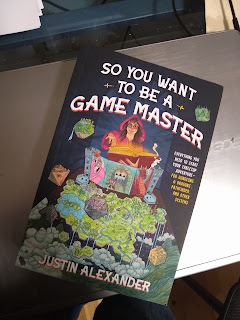Home: A Light in the Darkness, by Scott Wegener
Scott is also author of Glaive, a rules-lite OSR RPG built off the Knave chassis. I personally find Glaive to be a bit more readable variant of the two.
More importantly, Scott is also the artist on the long-running Atomic Robo comic, which if you haven't taken a look, I highly recommend.
Anyway, on to the actual topic of this review:
"Home" is a toolkit supplement designed to catalyse sandbox play by creating a base town with surrounding hexes, a threat on the horizon, a collection of resources, and a pathway for worldbuilding via play.
This is a good tool for players and gamerunners who enjoy playing characters starting at the "you're a nobody from nowhere" style of play, as well as players who like their gameplay to have a direct and tangible effect on their world.
At the heart of the "Home" approach is the "steading" or base town. At the beginning of play, the steading is little more than a wide spot in the road, or clearing in the woods, with the characters as locals with itchy feet.
The gamerunner plops the steading in the center of a hex, and builds out the six hexes surrounding the home hex (a bit more than Chgowiz's "
Just Three Hexes" concept). Two critical features are randomly placed, "The Old Road" and the "Long River." Then other general features are filled in, including terrain and seeding the map with resources (discussed more below).
The gamerunner conceptualizes a big-bad on the horizon, some adversary well beyond the PC's abilities, but who may be sending minions or creating other hazards in the world.
And we're off.
As I mentioned, the steading begins as a tiny community of generally fewer than 100 individuals. It may have an interesting feature or resident, such as a retired adventurer, shrine, or oddity. That element can either provide quests for our fledgling heroes, training, or be a draw for outsiders to visit the settlement. The characters are locals, likely farmers or semi-skilled laborers who want to see what's over the next hill. At first, this adventuring nonsense isn't even a full-time job. Their thorp exists at little more than a barter economy, saving what coins they have for perhaps a traveling tinker or blacksmith.
As the characters adventure, they generate or collect resources that allows their home town to grow. These may be in the form of lair cleared, skilled NPC attracted to town, or identification of local resources. With resources, the town may grow from the original thorp to a large town/small city of over 1,000 residents. Associated with the population growth comes the services and skilled classes attracted by the larger towns. As the PCs are citizen-adventurers, a part of gameplay also allows for downtime pursuits, including skill-building, leveling up, and starting new side ventures.
The 'resources' gathering may feel a bit video-gamey, but is a good metric for tracking settlement growth and, of course, may be adjusted to fit the individual game. Likewise, the growth of the town will probably not align 1:1 with character leveling, depending on if advancement is xp or milestone based. I wouldn't couple character advancement directly to town growth, treating them as separate advancements or mini-games.
The stated objective of this supplement is to take a party from around first to fifth level of play.
Outside of using this supplement whole cloth, it has a number of sections that may be useful for many tables: general hexcrawl procedures, faction design, a primer on slot-based inventory, and a solid NPC generator. Although my players are past the "nobodies from nowhere" stage, I'm planning on using the NPC generator and town growth mechanics within my game.
Everything is well-written and laid out in clear double columns. Each topic is covered in a succinct manor, and covered in between one-half to three pages. Peppered throughout is Wegener's whimsical and evocative art, some examples of which I've included above.
Either in whole or part, I'd recommend this as a good resource for developing sandbox play or modeling how your PCs' actions may effect their world.
"Home" weighs in at 40 pages, including an example sandbox scenario and thanks pages for KS backers.






Well damn you, forced me to go buy Home. Luckily I already had the Gamemaster book, otherwise I would have bought it as well!
ReplyDeleteHeh. $5 pdf, hope you can afford it!
DeleteSold a couple pairs of old socks, made $5.07! Just enough!
DeleteThis book is a great resource! I haven't had a chance to read the glaive rules yet but I'm excited.
ReplyDelete